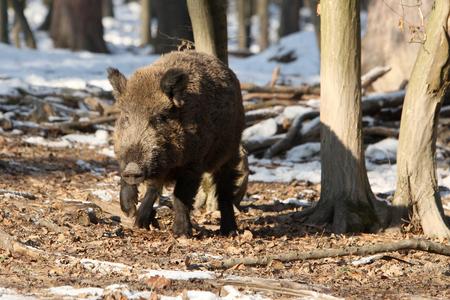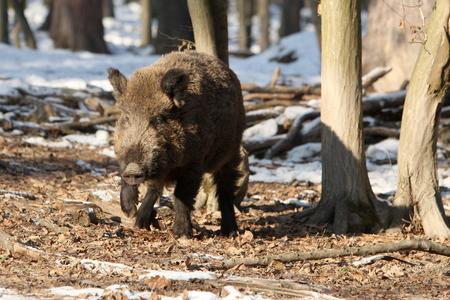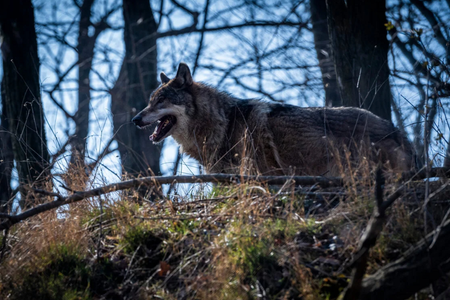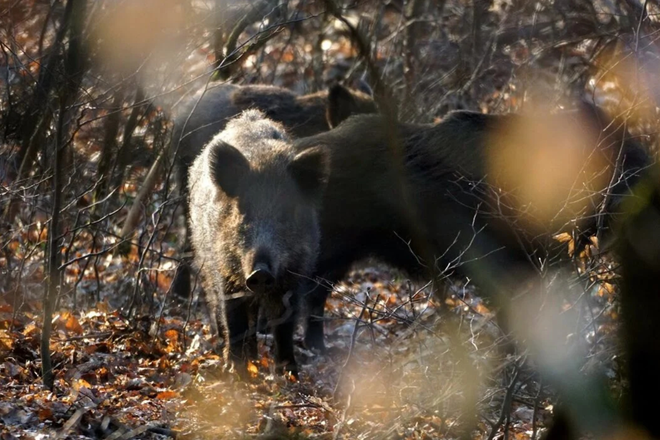It's either late in the evening or early in the morning when a hunter enters a forest. They come to a high stand somewhere off the tourist trails and wait. When a wild boar approaches, attracted by some corn, the hunter shoots the animal. The incident takes place in the Bratislava forest park without any visitor's knowledge.
"The majority of hunting takes place in this way," says Marek Páva, director of the Mestké Lesy v Bratislave municipal forest company.
Recently, proliferating wild boars have attracted a lot of attention in the capital, either because they ventured into housing estates, or thanks to the joint hunt organized by the forest company at the end of January, due to which a part of the forest park was closed.
During the morning, 80 participants caught three wild boars. "We expected more, but in recent years the number of wild boars in the forest has significantly decreased, mainly thanks to hunting from high stands," explains Páva.
The issue the city has nowadays is the wild animals that permanently roam the housing estates. "Shooting is prohibited in the inner city," explains Deputy Mayor Jakub Mrva, adding that the only thing the municipality can do is to capture them in cages.
What attracts the animals to the city are abandoned gardens, vineyards, where they find plenty of food and tranquility. Municipalities do not have any strong leverage to make owners do something about their property.

Hundreds of wild boars hunted from high stands
With a million visitors a year, the Bratislava forest park is among the most visited forests in Slovakia. Their primary function is recreation; any hunting activities are mainly aimed at maintaining animal numbers at a reasonable level and reducing the number of proliferating wild boars.
"For wild boars, the conditions are good here as their natural predator, the wolf, is nowhere to be found, making us fully dependent on hunters to regulate their numbers," explains Páva.
Since the beginning of the hunting season, hunters have caught 230 wild boars in the city's forests. "In the 1980s, up to 10 wild boars were caught in year in urban forests, and two years ago it was roughly 500, so we can see that they are significantly overpopulated," says Páva. He explains that wild boars have more young because they have enough food found mainly outside the forest. During warmer winters, the young do not die because they are not exposed to extreme weather conditions. Young wild boars become independent earlier and their reproduction curve increases.
In the frequented Bratislava forests, regular hunting is difficult. Runners and dog walkers are moving around in the forest from early morning until night, making the high stands the safest way to do so. "Hunters are equipped with thermal vision or night vision and other equipment. They know exactly what they are shooting at; when weather conditions are bad, they are prohibited from shooting. The stands are built in such a way that they are not directed towards any hiking trail," explains Mrva.
The forest company employs only one hunter, and if necessary three foresters can provide help. Therefore, members of a hunting association hunt in the forest park; those who pay an annual membership fee and have permission to hunt a certain number of animals in the urban forest area.

Mass hunting is a celebration
The joint hunt that took place at the end of January, only a supplementary form of hunting carried out once or twice a year due to it being demanding in terms of organisation, as well as requiring good conditions.
"Always in the morning of a workday during the off-season, in order to pose as little hindrance to visitors as possible. On the day of the hunt, part of the forest park is hermetically closed. We let visitors know about it in advance via information boards, news or social media. Around 200 hectares out of 3,000 hectares of forest are closed," describes Páva.
Early in the morning, patrols are set up in the forest to prevent potential visitors from entering the hunting area. Summoned police test the hunters for alcohol.
Employees of the forest company, hunters with trained dogs can also be found among the participants. During the hunt, the participants are divided into two groups. One goes with dogs and searches the bushes for wild boars and drives them towards the other group, which shoots them. "There is no need to imagine that the former are running. We often go very slowly and make our way through blackberries and other bushes," describes Páva.
Traditions are also taken into account when hunting together. "Tributes are paid to animals, shooters are awarded with a twig for their hat," says Páva.
On the given Wednesday, three wild boars were caught in this way, last year it was 12. "This reflects that, thanks to intensive hunting, their number has decreased," explains Páva.
A wild boar belongs to the hunter who caught it. Hunters can process them for their own purposes. "It's a lot of hard work when the boar is bigger, the hunter cannot carry it and has to call others to help them, it takes a long time. There is a lot of hard work behind every pot of goulash they make from the animal," states Páva.
In addition to wild boars, fallow deer are also hunted near Bratislava, which comes from the Záhorie region and is also overpopulated. "It happens that herds of fallow deer completely eat the young trees in some parts of the forest, so they have to be then fenced off and reforested," Páva explains.

Not all forests are urban
Bratislava can regulate the number of wild boars in the city forests. However, some forests in the vicinity belong to the state or there are private foresters; hunting in them is therefore ensured by hunters from other associations.
However, the most significant problem are posed by the wild animals already roaming the city.
"Old housing estates like the Kramáre neighbourhood were once full of gardens, with pears and apple trees. Brown-coloured containers with biodegradable waste now attract the animals," says Mrva. Municipal waste company OLO started to lock the containers in critical locations. "A magnetic gravity lock allows opening the container only when it is up. If a wild boar drops it or manipulates it, it won't open."
Since it is not possible to hunt wild boars in the inner city, the municipality tries to catch them in cages. "At the Koliba and Kramáre neighbourhoods, we have contracted veterinarians who place cages. Such wild boars are subsequently euthanised and disposed of in a slaughterhouse," says Mrva. To prevent the spread of African swine fever, it is not possible to move the wild boars to another place, their meat is also no longer usable because it contains chemicals.
"This is how we partially managed to contain a large herd of wild boars that roamed around Kramáre two years ago. We caught several dozen of them in the cages," says Mrva.
However, the problem cannot be solved as long as wild boars have found refuge in abandoned gardens and vineyards. "All three measures must be implemented at the same time: hunting in the forest, catching urban wild boars in cages, and destroying their shelters," says Páva.
It is difficult for the local government to convince the owners to remove blackberries from their plots or to mow them twice a year. "Often these are gardens that have several owners in inheritance proceedings, or their owners are waiting for the zoning plan to change, allowing them to build upon them. But in the meantime, they remain idle," says Mrva.
Municipalities can only do so much as to call upon the owners to clean up their plots. "When the owner does not fulfil their obligation, the city district should refer it to the district office, which can issue a fine," says Mrva.
Problems with wild boars plague many towns. A few days ago a herd of wild boars was roaming in the wider centre of Košice.
©Sme


 Wild board in the forests of Bratislava. (source: Jakub Mrva)
Wild board in the forests of Bratislava. (source: Jakub Mrva)